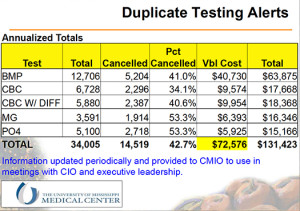Innovative medical laboratories shared their successes in improving lab test utilization that included physician engagement and close monitoring of key metrics
DATELINE: ORLANDO, FLORIDA—One big challenge facing medical laboratories and anatomic pathology groups in the United States today is the need to transition from a transaction-based business model (increasing specimen volume leads to increasing revenue) to a value-based business model (helping providers improve their use of clinical laboratory tests in ways that measurably improve patient outcomes while controlling or reducing the cost of care.)
Two trends reinforce the need for clinical laboratories to craft strategies to develop new ways to add value to lab testing services.
One trend is the move by Medicare and private health insurers to shift reimbursement for providers away from fee-for-service and toward bundled reimbursement and budgeted reimbursement.
The second trend is the emergence of integrated clinical care organizations. The most visible of these are accountable care organizations (ACO) and patient-centered medical homes (PCMH). What these care delivery organizations have in common is that they require hospitals, physicians, clinical laboratories, imaging centers, nursing homes and other types of providers to work together more effectively so that patients receive healthcare in a seamless fashion because there is a continuum: primary care to specialty care to acute care and back again.
Clinical Laboratories Need to Deliver More Value in Support of Patient Care
Last week in Orlando, Florida, the issue of how clinical laboratories can deliver value to ACOs, medical homes, and other types of integrated healthcare organizations was the central theme in the opening session of Orchard Software’s annual User Group and Symposium. Your Dark Daily Editor was in attendance to provide a strategic view of what’s changing in healthcare, and how early-adopter medical laboratories and pathology groups are innovating to add value to their lab testing services.
One pathologist who has actively engaged his laboratory and parent healthcare organization in initiatives to combine lab test data with other clinical information in ways that eliminate unnecessary costs and improve patient outcomes is Brad Brimhall, M.D., who is a Professor of Clinical Pathology at University of Mississippi Medical Center. He delivered a presentation in tandem with Matt Modleski, Vice President of Business Development at Orchard Software that was titled, “The Value of Building Collaborative Relationships Outside of the Laboratory.”

Pathologist Brad Brimhall, M.D., has been involved in innovative programs wherein clinical laboratories collaborate with physicians and hospital administrators to develop programs that help physicians get more value in how they utilize medical laboratory tests. Last week in Orlando, Brimhall and co-presenter Matt Modleski of Orchard Software delivered a presentation that reported on successful efforts to engage physicians in ways that add value and improve patient care. (Photo by Kerry Forster and copyright Orchard Software.)
Brimhall presented metrics and outcome data from lab test utilization programs he participated in at the University of Mississippi Medical Center in Oxford. The activities ranged from:
- programs that use electronic alerts in the electronic health record (EHR) to notify physicians that the proposed test order may be inappropriate or unnecessary, and,
- that flag duplicate tests at the time a physician wants to enter an order,
to reviews of:
- long-standing ordering sets coded into the health systems computers to identify clinical laboratory tests that should not be in those order sets, and,
- the use of medical laboratory tests to identify patients with antibiotic resistant strains of infectious diseases early in the diagnostic process to help physicians avoid prescribing an expensive antibiotic drug that won’t be effective for the patient, thus improving outcomes and reducing the cost of prescribing ineffective antibiotics.
Reporting on Positive Outcomes at University of Mississippi Med Center
Information was presented by Brimhall to show the positive outcomes that resulted from these collaborations involving the medical laboratory, physicians, and clinical staff at the medical center. For example, the project to alert physicians to duplicate tests when a physician went into the system to place an order produced impressive results. In the case of BMP, during the course of one year, there were 12,706 orders for BMP placed in the computer. However, because of duplicate test alerts, 5,204—or 41% of those test orders—were cancelled. That results in savings of $63,875 in lab costs just for BMP!

At the University of Mississippi Medical Center, pathologists and medical laboratory scientists collaborated with physicians and administration in a project to use duplicate testing alerts in the medical center’s electronic ordering system as a way to help physicians reduce unnecessary lab tests. As the chart above demonstrates, for just five types of clinical laboratory tests, the duplicate test alert helped physicians cancel 42.7% of the original test orders. Savings in the medical laboratory were calculated at $131,423, or the equivalent of the salaries of 3.2 lab employees. (Chart by pathologist Brad Brimhall, M.D., rights reserved by Brad Brimhall, M.D.)
For the six medical laboratory tests highlighted by Brimhall, a total of 34,005 test orders were initated and 14,519—or 42.7% of these orders—were cancelled. This saved the health system $131,423 in total laboratory costs.
During his remarks, Brimhall had a useful recommendation for his audience. He suggested that hospital and health system administration pay much closer attention to these types of clinical laboratory test utilization projects when the savings are presented not just in dollar terms, but also in how many full-time jobs were saved. “Assume an average cost of about $40,000 for a medical technologist,” observed Brimhall. “We can then characterize the savings from duplicate lab test alerts for these six tests as not just $131,423, but also as 3.2 lab FTEs. Many hospital administrators relate strongly to this outcome because they want to provide employment stability to staff even as they successfully cut unnecessary costs.”
How to Use a Medical Laboratory Test Formulary and Algorithms
The following speaker continued the theme of identifying opportunities for the clinical laboratory to deliver more value with its lab testing services. Leo Serrano, FACHE, DLM(ASCP), and most recently Corporate Director of Laboratory Services at Broward Health in Fort Lauderdale, Florida, presented a session titled “Using a Lab Formulary, Algorithms, and CPOE to Significantly Reduce Lab Test Utilization.”

During his remarks at the Orlando conference last week, Leo Serrano, FACHE, DLM(ASCP) shared how the clinical laboratory at Broward Health engaged with physicians and administrators to identify and implement opportunities to improve the utilization of medical lab testing services. Serrano, who until recently was the Corporate Director of Laboratory Services at Broward Health, described how, over the two-year period of 2013 and 2014, such lab-physician collaborations delivered about $1.4 million in direct cost reductions of lab tests and blood products while contributing to better patient care. (Photo by Kerry Foster and copyright Orchard Software.)
“There are great opportunities for lab professionals to collaborate with clinicians specifically to help physicians with more accurate diagnoses while better managing the cost of care,” noted Serrano. “What is true for us at Broward Health is equally true at other health systems and hospitals. For starters, there are unnecessary, outdated, or inappropriate tests and these cost more—not just financially—but also in terms of care.
“At the same time, as newer lab tests are introduced, not all have true clinical value and many simply add cost without contributing to better patient outcomes,” he continued. “Pathologists and medical laboratory scientists can play an essential role in working with physicians to help them understand when such tests contribute to better patient care and when they don’t.
Pathologists Can Help Doctors with Today’s Overload of New Clinical Information
Serrano also called attention to the fact that physicians today are burdened with information overload. “Too much information is being thrown at physicians, particularly as new diagnostics and new therapeutics are introduced into clinical care,” stated Serrano. “Lab professionals can play an important role in filtering this information to ensure that physicians are up to date with what’s most relevant for their patients and their medical practice.”
“However, as the laboratory engages with other clinicians, it is important that the approach to establishing programs to improve outcomes and reduce costs that involve medical laboratory tests not be dictated by the laboratory nor by pathology,” he noted.
“In our experience, what works best is that these efforts be seen as clinician-initiated best practice.
“That can be accomplished by organizing a multi-specialty committee comprised of clinicians with assistance and guidance from the laboratory,” continued Serrano. “At Broward Health, we patterned this after the pharmacy formulary and it was well-received by both physicians and administration.”
Savings of $1.4 Million in Medical Laboratory and Blood Product Costs
Serrano shared impressive outcomes with the audience. Broward Health is comprised of six hospitals, plus associated clinics and providers. It is the nation’s tenth largest public healthcare system and has the second busiest ED and trauma service in Florida. Between July 2012 and July 2013, the different initiatives to improve utilization of clinical lab testing delivered estimated savings of $871,000. During 2014, an additional $531,000 was saved because of these efforts to add value to medical laboratory testing services.
The case studies of improved medical laboratory test utilization at University of Mississippi Medical Center and Broward Health are useful examples of how some first-mover clinical laboratory organizations are succeeding in their efforts to help physicians get more value from lab tests. One interesting development announced by Orchard Software at this meeting in Orlando last week is that it is conducting a School for Medical Analytics in Indianapolis on October 18, 2015.
This program is designed to help all lab professionals learn the necessary steps to identify opportunities to add value to lab testing services, then engage physicians to help implement these projects. Brad Brimhall, M.D., will be one of the faculty members. Subjects to be taught include:
- Healthcare organizational structures,
- Cost accounting,
- Accounting for quality,
- Medical data and databases, and,
- A review of analytics projects and presentation skills
Details on how to attend this program be found at Orchard Software’s website (or at this URL: http://blog.orchardsoft.com/?p=1277).
Finally, it should be noted that there are important differences in projects that are designed to help physicians avoid ordering medical laboratory tests that are outmoded, unnecessary or inappropriate, and in those projects that are design to help physicians make smarter decisions about how to use lab tests that can improve diagnostic accuracy and then use the results of those clinical lab tests to do a better job of identifying the best therapy for the patient.
The former projects directly reduce the cost of lab tests and decrease waste. But it is the latter types of projects that have the most potential because they are designed to directly improve diagnostic accuracy and contribute to how physicians achieve improved patient outcomes that can result in sizeable savings in the total cost of patient care.
Yours truly,
Robert L. Michel
Editor, Dark Daily
Related Information:
Leveraging Lab Information to Benefit Healthcare in a Non-Fee-for-Service Environment
HHS Faces Daunting Challenge in Moving Away from Fee-For-Service Payment


